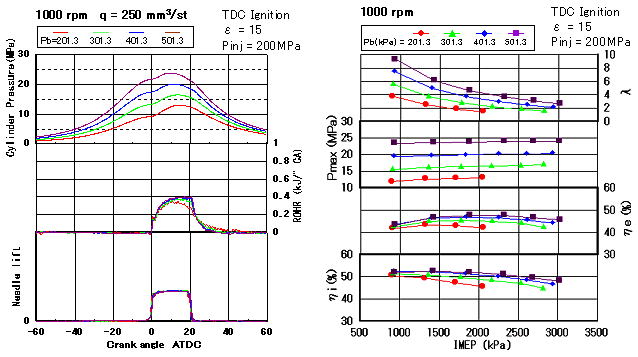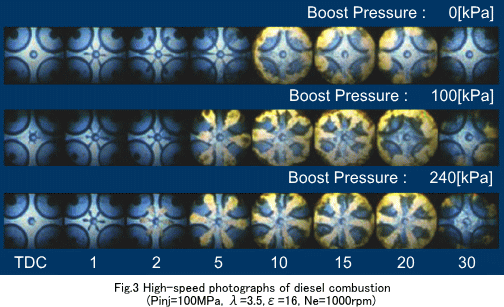
Hiroshi Ogawa
President
New ACE Institute Co., Ltd. |
|
 |
|
New ACE started a new project of four years on April 2002. The project
target is set for future regulatatioin, due to the strong and worldwide
need for the reduction of exhaust emissions and CO2 in diesel engines.
It was announced that the Japanese newest PPNLT regulation would be in
operation in 2016, and the world harmonized and transient test cycle would
be adopted. The advanced and extended combustion technologies, including
the after-treatments and the low emission fuels, have been important to
achieve the drastic reductions of NOx and PM.
In Europe and the United States, diesel engines have been improving
progressively by advanced technology, requiring low exhaust emissions,
low fuel consumption and producing high output power.
Taking into consideration the future requirements for these situations
and the reduction of exhaust emissions, the project target is to make low
exhaust emissions and smokeless, and the low CO2 exhaust level.
Focusing on our high target for the reduction of exhaust emissions, we applied for the national Project of "The Development of the Super Clean Diesel Engine" and succeeded. Although this may be an enormous task, we regard it as very rewarding because we can contribute the result of our project to worldwide society.
|
 |
For the technology aiming at low exhaust emissions and large reductions
of CO2, the turbo-charged system that takes in a larger amount of intake
air into the cylinder than the current turbo-intercooler (TI) and a cooled
EGR system will be adopted, and the common rail fuel injection system and
combustion chamber suitable to new diesel combustion should be installed.
Furthermore, the new diesel combustion must give satisfaction to be
applicable to the advanced after-treatment. As the future diesel engine
needs twice of the maximum cylinder pressure (Pmax) in order to increase
the thermal efficiency, the strength of engine has been bearable up to
twice Pmax of the current engines.
Under the injector specifications of 0.17mm diameter and 6 hole nozzles
and injection pressure 200-250MPa in our single cylinder engine (bore×stroke:135×140mm),
the amount of air was increased up to 5 times of NA engine by increasing
the boost pressure (Pb = 400 kPa gage).
New ACE now introduces the experimental results that have been just
obtained with our newly installed experiment system. |
 |
3-1. High boosting combustion
The variation of the pressure diagram and the heat release rate are
shown in Fig.1, when the boost pressure increased. The heat release rate
with twice the amount of intake air of NA engine and under the boost pressure
Pb = 100kPa shows rather slow combustion in comparison with high boost
pressure conditions and it is expected that the combustion will change
to high rate and this gives the high thermal efficiency under the condition
of a larger amount of intake air such as high boost pressures, Pb=200-500kPa. |
3-2. Thermal efficiency by high boosting
The variations of Pmax and the brake thermal efficiency (η fb) when
the indicated mean effective pressure, IMEP, was increased up to 3000 kPa,
are shown in Fig. 2. In case of turbo-charging to the current heavy duty
TI engine, of which the amount of air was twice of NA engine under the
boost pressure Pb=100kPa, and it shows that the more the air increases,
the more the brake thermal efficiency improves.
In addition, an interesting result was obtained - the more the degree
of super-charging increases, the more the peak of brake thermal efficiency
moves to the high IMEP side. Before the experiment there was an anxiety,
that is, the brake thermal efficiency with an increased Pmax would not
improve because of the increased frictions by Pmax, but it proved not to
be the case. |
3-3. Combustion photographs by high boosting
Fig 3 shows the combustion photograghs under the conditions in which
the intake air was increased to approximately 3.5 times of NA engine, the
air excess ratioλ= 3.5 constant, the nozzle specification remained the
same and the injection pressure was 100MPa. Those photograghs show that
when the boost pressure increased the combustion started at the same time
as the fuel injection due to the ignition occurred soon and that the burning
part and the unused air region separated distinctly.
A moving image shows more clearly that under the high boosting, the
burning part and unused air part separated and it is assumed that those
parts cannot mix easily because of the large difference in their densities. Consequently,
it is very important to invent the devices that can mix the burning and
unused air parts easily under the high boosting. |
 |
| New ACE has introduced briefly the experimental results above mentioned
and will make an effort to accomplish the new combustion task for clean
diesel engine with fresh minds aiming to contribute to the society. |
|

